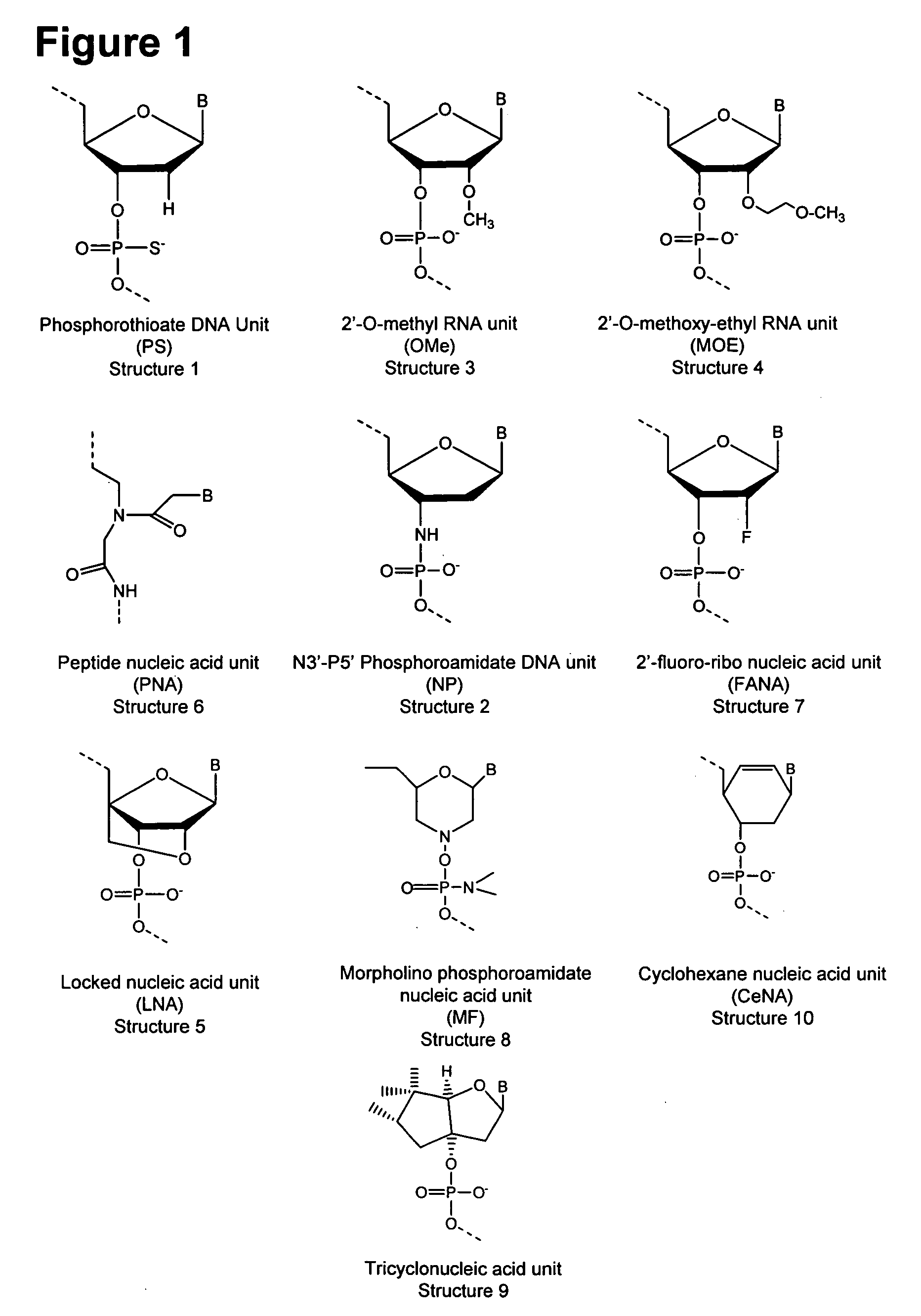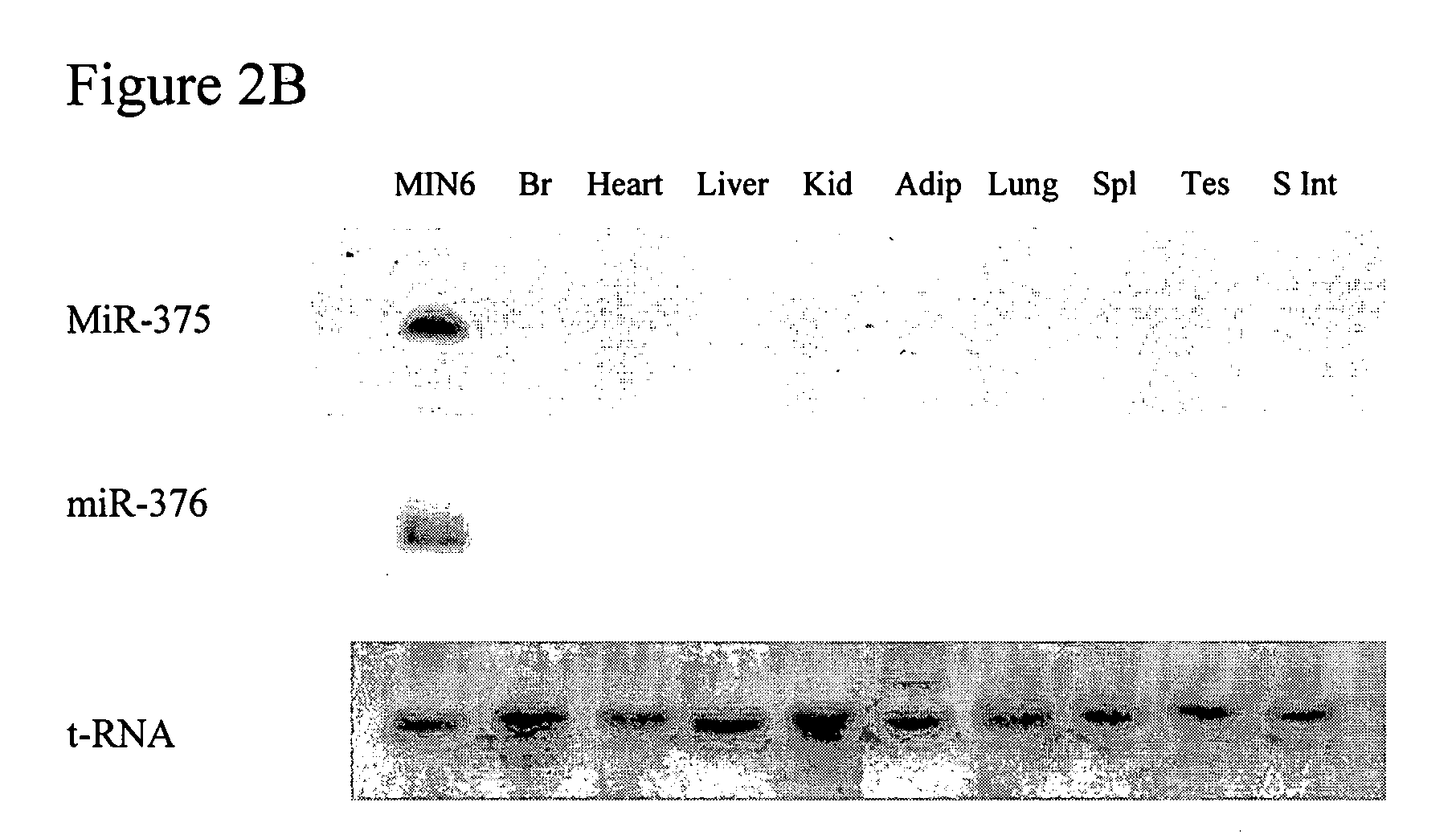Pancreatic islet microRNA and methods for inhibiting same
a technology of pancreatic islet and inhibitory method, which is applied in the direction of drug composition, genetic material ingredients, metabolic disorders, etc., can solve the problems of diabetes, diseases and illnesses such as diabetes, and achieve the effect of inhibiting micrornp activity and inhibiting micrornp activity
- Summary
- Abstract
- Description
- Claims
- Application Information
AI Technical Summary
Benefits of technology
Problems solved by technology
Method used
Image
Examples
example 1
Materials and Methods
[0116] MicroRNA cloning and Northern blotting analysis: 600 μg of total RNA was isolated from MIN6 cell cultures using TRIZOL reagent (Invitrogen) and miRNA cloning was performed as previously described (Lagos-Quintana, Current Biol.). Antisense probes were designed to complement cloned miRNA sequences and used for Northern blot analysis as previously described (Lagos-Quintana, Current Biol.).
[0117] Cell culture: MIN6 cells were cultured with DMEM medium containing 25 mM glucose, 15% fetal bovine serum, and 5.5 μM 2-mercaptoethanol. N2A cells were cultured with DMEM medium containing 25 mM glucose and 10% fetal bovine serum.
[0118] Insulin secretion studies: MIN6 cells were cultured in 24-well plates for 2 days and washed with a modified Krebs-Ringer buffer (KRBH) (0.9 mM CaCl2, 2.68 mM KCl, 1.46 mM KH2PO4, 0.5 mM MgCl2. 6H2O, 135 mM NaCl, 8 mM Na2HPO4×7H2O, 20 mM Hepes, and 0.2% BSA) prior to the assay. After a 30 minute pre-incubation with KRBH containing 5....
example 2
Pancreatic Islet microRNAs
[0128] MicroRNAs from MIN6 cells, a glucose responsive murine pancreatic β-cell line were cloned. We obtained a total of 301 microRNAs clones, which contained 55 different microRNAs. Of the 55 different microRNAs, 92% represented previously identified microRNAs and 8% were as-yet unidentified microNAs. Known and novel miRNAs were identified in various genome databases by Blast sequence analysis and confirmed by cross-species homology and their ability to form typical hairpin precursor structures.
[0129] A total of 9 novel microRNAs were identified and a single microRNA (miR-375) represented >50% of all novel clones (FIG. 2a). We next investigated the expression of novel microRNAs by Northern blot analysis. Only microRNAs 375 and 376 could be detected by Northern blot analysis from MIN6 cells and pancreatic islets (FIG. 2b). The expression of both microRNAs was restricted to MIN6 cells and pancreatic islets and not found in other tissues including liver, lu...
example 3
Inhibitory Action of miR-375 on Secretion
[0130] To analyze the function of the microRNAs with high expression levels and relative tissue specificity for pancreatic β-cells, we tested the effect of synthetic siRNAs with homologous sequence to microRNAs -375 and -376 on glucose-induced insulin secretion in MIN6 cell following transfection. In addition to the siRNAs, we cotranfected a vector expressing the human growth hormone (hGH) gene under the control of a CMV promoter (CMV-hGH). Exogenously expressed hGH has been previously shown to be targeted to secretory granules of pancreatic b-cell lines and to be co-released with insulin after triggering of exocytosis. This approach allowed us to monitor exocytosis selectively from transiently transfected MIN6 cells (transfection efficiency 20-30%). As positive and negative controls, siRNAs targeting the glucokinase gene (Gck) or apolipoprotein M (apoM), a gene not expressed in pancreatic β-cells, were cotranfected with CMV-hGH into MIN6 ce...
PUM
| Property | Measurement | Unit |
|---|---|---|
| frequency | aaaaa | aaaaa |
| wavelength | aaaaa | aaaaa |
| wavelength | aaaaa | aaaaa |
Abstract
Description
Claims
Application Information
 Login to View More
Login to View More - R&D
- Intellectual Property
- Life Sciences
- Materials
- Tech Scout
- Unparalleled Data Quality
- Higher Quality Content
- 60% Fewer Hallucinations
Browse by: Latest US Patents, China's latest patents, Technical Efficacy Thesaurus, Application Domain, Technology Topic, Popular Technical Reports.
© 2025 PatSnap. All rights reserved.Legal|Privacy policy|Modern Slavery Act Transparency Statement|Sitemap|About US| Contact US: help@patsnap.com



